Optimization of Waste Management System using Linear Programming
VerifiedAdded on 2023/06/11
|17
|2740
|364
AI Summary
This article discusses the optimization of waste management system using linear programming with solved examples and models. It includes a multiple-objective linear programming (MOLP) model for waste management, a GP model to optimize both objectives simultaneously, and a prioritization method for factors affecting van selection. The article also provides recommendations based on the models and analysis.
Contribute Materials
Your contribution can guide someone’s learning journey. Share your
documents today.
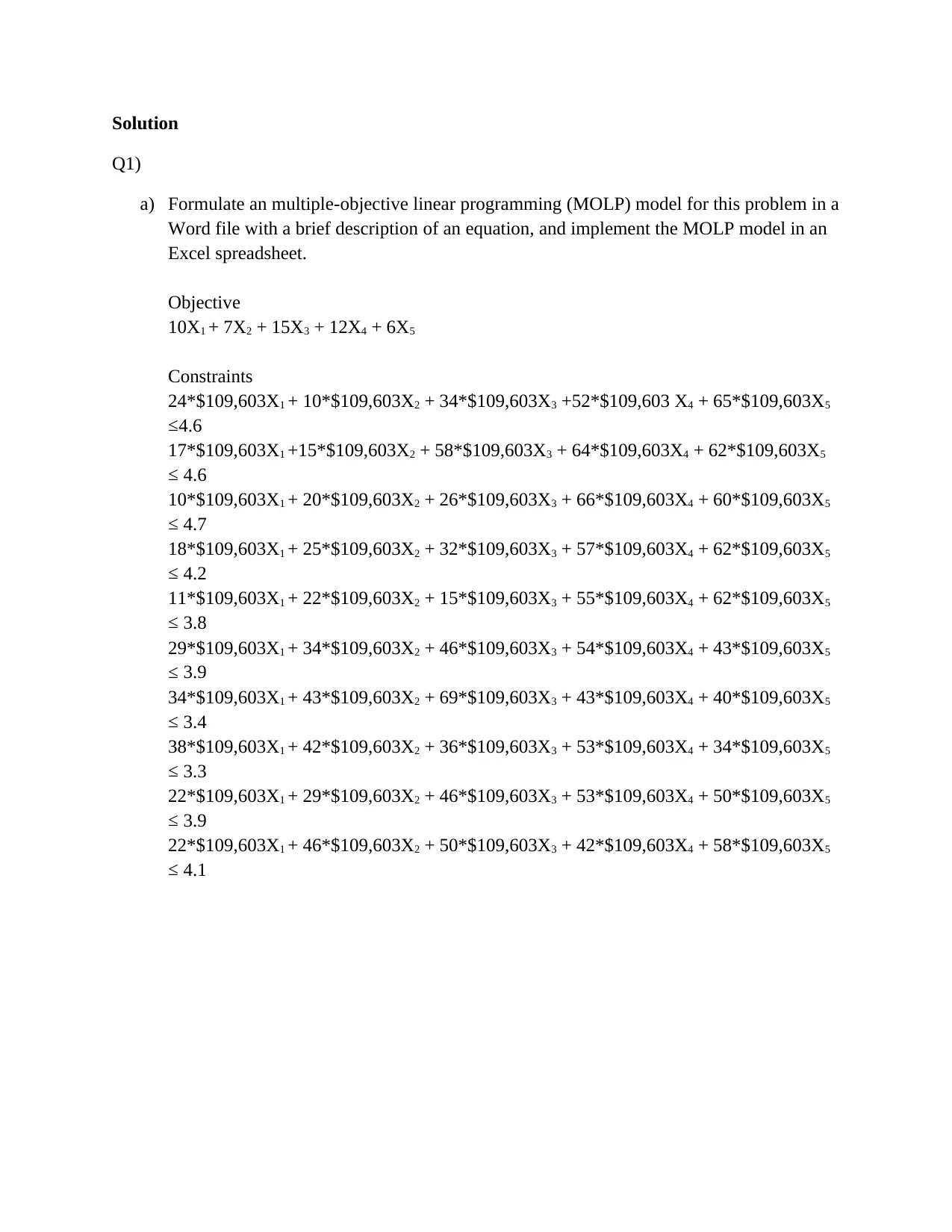
Solution
Q1)
a) Formulate an multiple-objective linear programming (MOLP) model for this problem in a
Word file with a brief description of an equation, and implement the MOLP model in an
Excel spreadsheet.
Objective
10X1 + 7X2 + 15X3 + 12X4 + 6X5
Constraints
24*$109,603X1 + 10*$109,603X2 + 34*$109,603X3 +52*$109,603 X4 + 65*$109,603X5
≤4.6
17*$109,603X1 +15*$109,603X2 + 58*$109,603X3 + 64*$109,603X4 + 62*$109,603X5
≤ 4.6
10*$109,603X1 + 20*$109,603X2 + 26*$109,603X3 + 66*$109,603X4 + 60*$109,603X5
≤ 4.7
18*$109,603X1 + 25*$109,603X2 + 32*$109,603X3 + 57*$109,603X4 + 62*$109,603X5
≤ 4.2
11*$109,603X1 + 22*$109,603X2 + 15*$109,603X3 + 55*$109,603X4 + 62*$109,603X5
≤ 3.8
29*$109,603X1 + 34*$109,603X2 + 46*$109,603X3 + 54*$109,603X4 + 43*$109,603X5
≤ 3.9
34*$109,603X1 + 43*$109,603X2 + 69*$109,603X3 + 43*$109,603X4 + 40*$109,603X5
≤ 3.4
38*$109,603X1 + 42*$109,603X2 + 36*$109,603X3 + 53*$109,603X4 + 34*$109,603X5
≤ 3.3
22*$109,603X1 + 29*$109,603X2 + 46*$109,603X3 + 53*$109,603X4 + 50*$109,603X5
≤ 3.9
22*$109,603X1 + 46*$109,603X2 + 50*$109,603X3 + 42*$109,603X4 + 58*$109,603X5
≤ 4.1
Q1)
a) Formulate an multiple-objective linear programming (MOLP) model for this problem in a
Word file with a brief description of an equation, and implement the MOLP model in an
Excel spreadsheet.
Objective
10X1 + 7X2 + 15X3 + 12X4 + 6X5
Constraints
24*$109,603X1 + 10*$109,603X2 + 34*$109,603X3 +52*$109,603 X4 + 65*$109,603X5
≤4.6
17*$109,603X1 +15*$109,603X2 + 58*$109,603X3 + 64*$109,603X4 + 62*$109,603X5
≤ 4.6
10*$109,603X1 + 20*$109,603X2 + 26*$109,603X3 + 66*$109,603X4 + 60*$109,603X5
≤ 4.7
18*$109,603X1 + 25*$109,603X2 + 32*$109,603X3 + 57*$109,603X4 + 62*$109,603X5
≤ 4.2
11*$109,603X1 + 22*$109,603X2 + 15*$109,603X3 + 55*$109,603X4 + 62*$109,603X5
≤ 3.8
29*$109,603X1 + 34*$109,603X2 + 46*$109,603X3 + 54*$109,603X4 + 43*$109,603X5
≤ 3.9
34*$109,603X1 + 43*$109,603X2 + 69*$109,603X3 + 43*$109,603X4 + 40*$109,603X5
≤ 3.4
38*$109,603X1 + 42*$109,603X2 + 36*$109,603X3 + 53*$109,603X4 + 34*$109,603X5
≤ 3.3
22*$109,603X1 + 29*$109,603X2 + 46*$109,603X3 + 53*$109,603X4 + 50*$109,603X5
≤ 3.9
22*$109,603X1 + 46*$109,603X2 + 50*$109,603X3 + 42*$109,603X4 + 58*$109,603X5
≤ 4.1
Secure Best Marks with AI Grader
Need help grading? Try our AI Grader for instant feedback on your assignments.
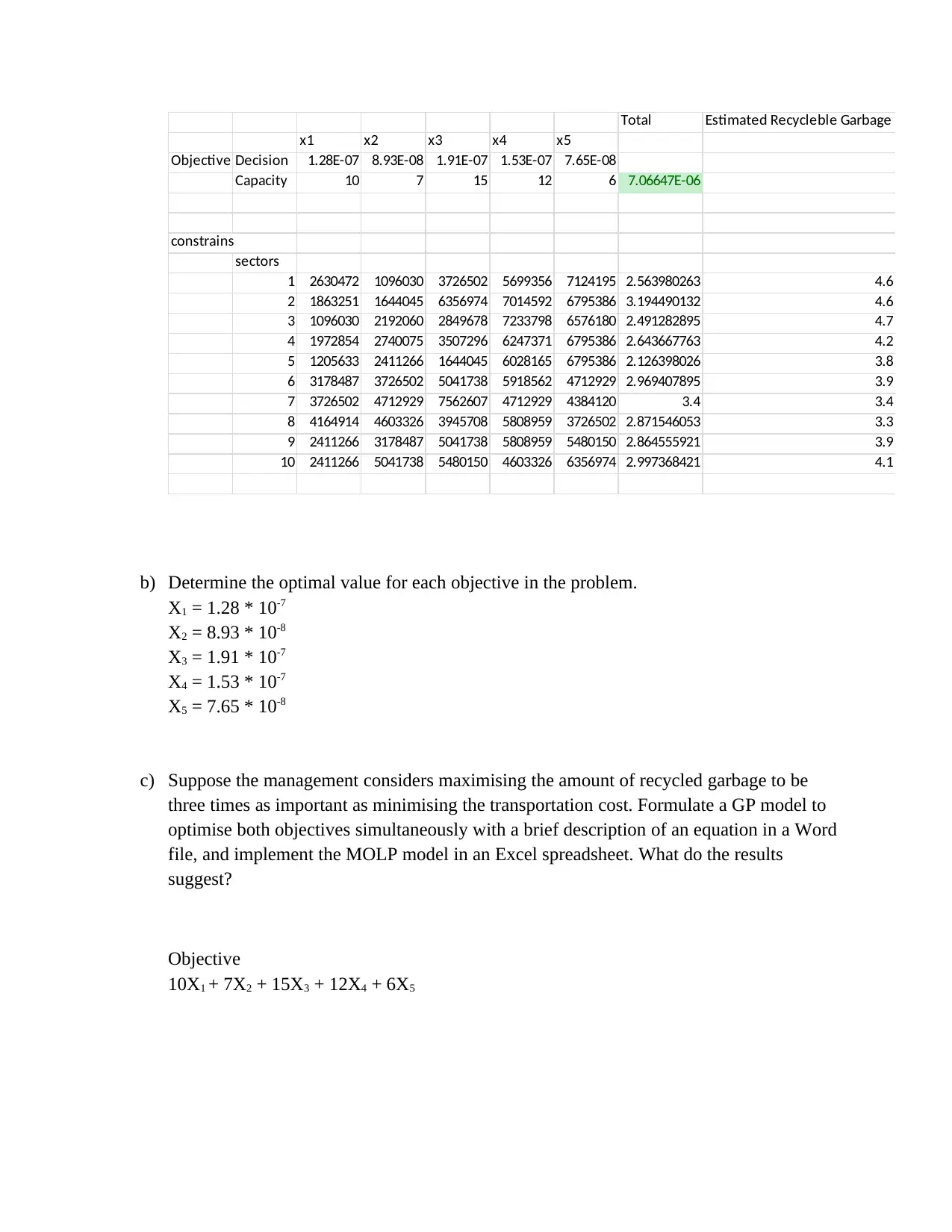
Total Estimated Recycleble Garbage
x1 x2 x3 x4 x5
Objective Decision 1.28E-07 8.93E-08 1.91E-07 1.53E-07 7.65E-08
Capacity 10 7 15 12 6 7.06647E-06
constrains
sectors
1 2630472 1096030 3726502 5699356 7124195 2.563980263 4.6
2 1863251 1644045 6356974 7014592 6795386 3.194490132 4.6
3 1096030 2192060 2849678 7233798 6576180 2.491282895 4.7
4 1972854 2740075 3507296 6247371 6795386 2.643667763 4.2
5 1205633 2411266 1644045 6028165 6795386 2.126398026 3.8
6 3178487 3726502 5041738 5918562 4712929 2.969407895 3.9
7 3726502 4712929 7562607 4712929 4384120 3.4 3.4
8 4164914 4603326 3945708 5808959 3726502 2.871546053 3.3
9 2411266 3178487 5041738 5808959 5480150 2.864555921 3.9
10 2411266 5041738 5480150 4603326 6356974 2.997368421 4.1
b) Determine the optimal value for each objective in the problem.
X1 = 1.28 * 10-7
X2 = 8.93 * 10-8
X3 = 1.91 * 10-7
X4 = 1.53 * 10-7
X5 = 7.65 * 10-8
c) Suppose the management considers maximising the amount of recycled garbage to be
three times as important as minimising the transportation cost. Formulate a GP model to
optimise both objectives simultaneously with a brief description of an equation in a Word
file, and implement the MOLP model in an Excel spreadsheet. What do the results
suggest?
Objective
10X1 + 7X2 + 15X3 + 12X4 + 6X5
x1 x2 x3 x4 x5
Objective Decision 1.28E-07 8.93E-08 1.91E-07 1.53E-07 7.65E-08
Capacity 10 7 15 12 6 7.06647E-06
constrains
sectors
1 2630472 1096030 3726502 5699356 7124195 2.563980263 4.6
2 1863251 1644045 6356974 7014592 6795386 3.194490132 4.6
3 1096030 2192060 2849678 7233798 6576180 2.491282895 4.7
4 1972854 2740075 3507296 6247371 6795386 2.643667763 4.2
5 1205633 2411266 1644045 6028165 6795386 2.126398026 3.8
6 3178487 3726502 5041738 5918562 4712929 2.969407895 3.9
7 3726502 4712929 7562607 4712929 4384120 3.4 3.4
8 4164914 4603326 3945708 5808959 3726502 2.871546053 3.3
9 2411266 3178487 5041738 5808959 5480150 2.864555921 3.9
10 2411266 5041738 5480150 4603326 6356974 2.997368421 4.1
b) Determine the optimal value for each objective in the problem.
X1 = 1.28 * 10-7
X2 = 8.93 * 10-8
X3 = 1.91 * 10-7
X4 = 1.53 * 10-7
X5 = 7.65 * 10-8
c) Suppose the management considers maximising the amount of recycled garbage to be
three times as important as minimising the transportation cost. Formulate a GP model to
optimise both objectives simultaneously with a brief description of an equation in a Word
file, and implement the MOLP model in an Excel spreadsheet. What do the results
suggest?
Objective
10X1 + 7X2 + 15X3 + 12X4 + 6X5
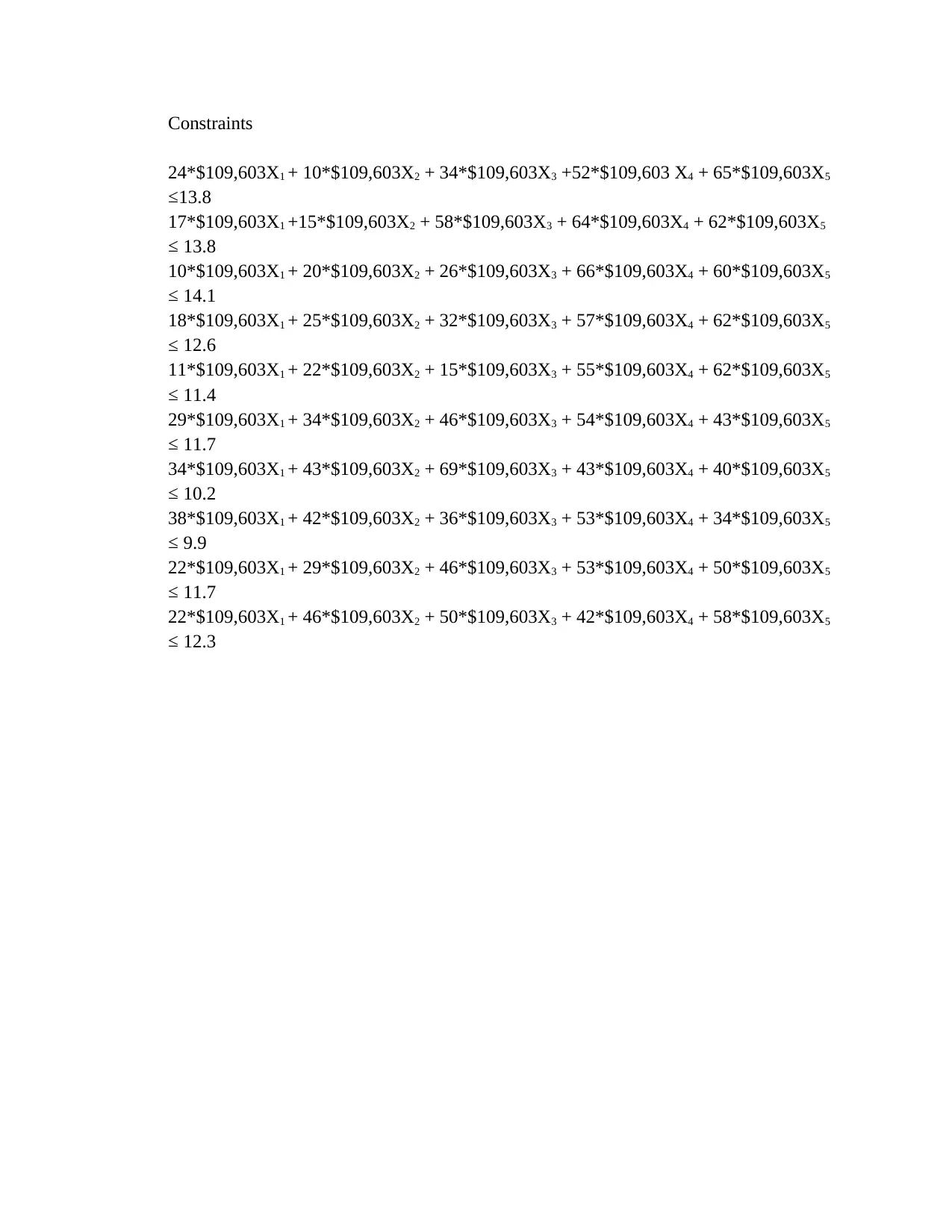
Constraints
24*$109,603X1 + 10*$109,603X2 + 34*$109,603X3 +52*$109,603 X4 + 65*$109,603X5
≤13.8
17*$109,603X1 +15*$109,603X2 + 58*$109,603X3 + 64*$109,603X4 + 62*$109,603X5
≤ 13.8
10*$109,603X1 + 20*$109,603X2 + 26*$109,603X3 + 66*$109,603X4 + 60*$109,603X5
≤ 14.1
18*$109,603X1 + 25*$109,603X2 + 32*$109,603X3 + 57*$109,603X4 + 62*$109,603X5
≤ 12.6
11*$109,603X1 + 22*$109,603X2 + 15*$109,603X3 + 55*$109,603X4 + 62*$109,603X5
≤ 11.4
29*$109,603X1 + 34*$109,603X2 + 46*$109,603X3 + 54*$109,603X4 + 43*$109,603X5
≤ 11.7
34*$109,603X1 + 43*$109,603X2 + 69*$109,603X3 + 43*$109,603X4 + 40*$109,603X5
≤ 10.2
38*$109,603X1 + 42*$109,603X2 + 36*$109,603X3 + 53*$109,603X4 + 34*$109,603X5
≤ 9.9
22*$109,603X1 + 29*$109,603X2 + 46*$109,603X3 + 53*$109,603X4 + 50*$109,603X5
≤ 11.7
22*$109,603X1 + 46*$109,603X2 + 50*$109,603X3 + 42*$109,603X4 + 58*$109,603X5
≤ 12.3
24*$109,603X1 + 10*$109,603X2 + 34*$109,603X3 +52*$109,603 X4 + 65*$109,603X5
≤13.8
17*$109,603X1 +15*$109,603X2 + 58*$109,603X3 + 64*$109,603X4 + 62*$109,603X5
≤ 13.8
10*$109,603X1 + 20*$109,603X2 + 26*$109,603X3 + 66*$109,603X4 + 60*$109,603X5
≤ 14.1
18*$109,603X1 + 25*$109,603X2 + 32*$109,603X3 + 57*$109,603X4 + 62*$109,603X5
≤ 12.6
11*$109,603X1 + 22*$109,603X2 + 15*$109,603X3 + 55*$109,603X4 + 62*$109,603X5
≤ 11.4
29*$109,603X1 + 34*$109,603X2 + 46*$109,603X3 + 54*$109,603X4 + 43*$109,603X5
≤ 11.7
34*$109,603X1 + 43*$109,603X2 + 69*$109,603X3 + 43*$109,603X4 + 40*$109,603X5
≤ 10.2
38*$109,603X1 + 42*$109,603X2 + 36*$109,603X3 + 53*$109,603X4 + 34*$109,603X5
≤ 9.9
22*$109,603X1 + 29*$109,603X2 + 46*$109,603X3 + 53*$109,603X4 + 50*$109,603X5
≤ 11.7
22*$109,603X1 + 46*$109,603X2 + 50*$109,603X3 + 42*$109,603X4 + 58*$109,603X5
≤ 12.3
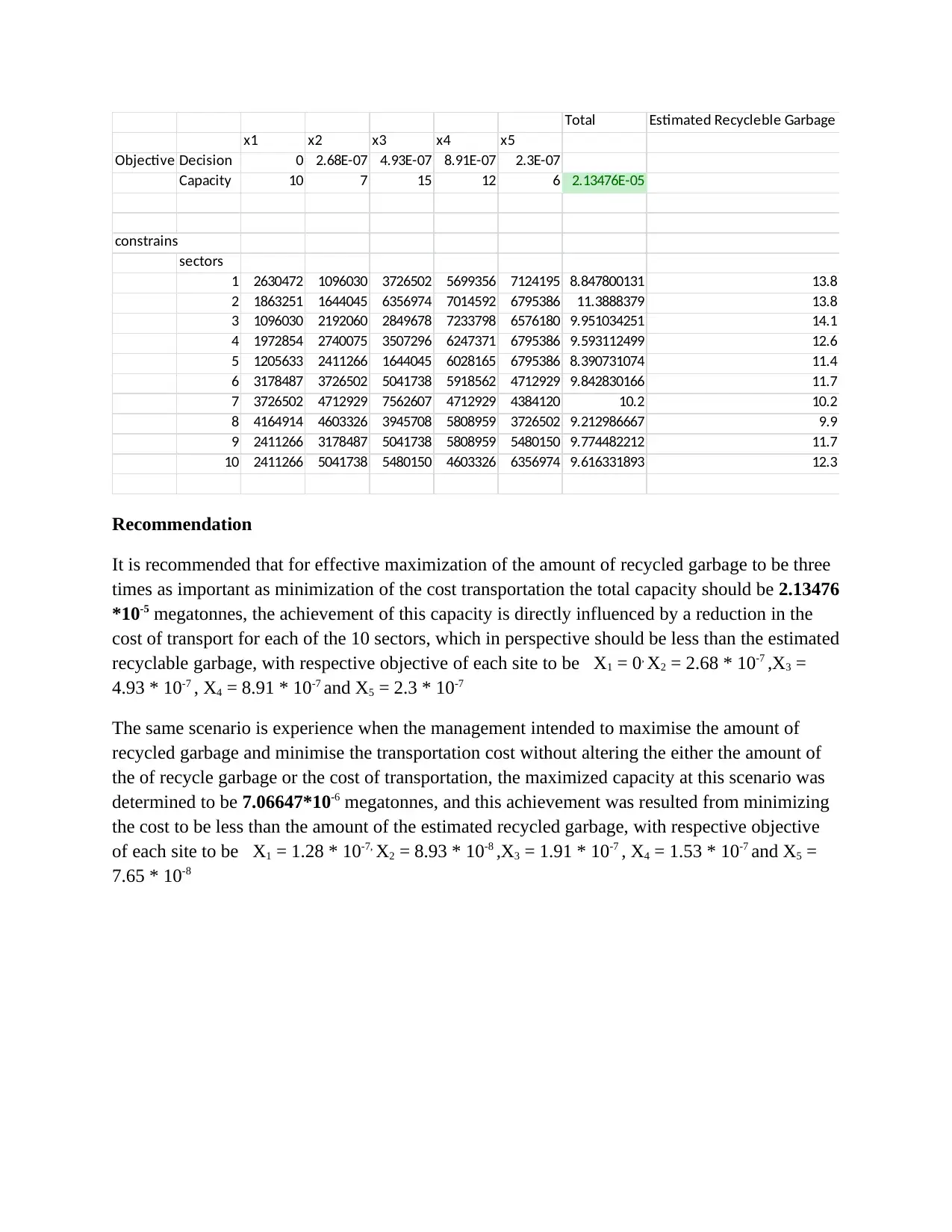
Total Estimated Recycleble Garbage
x1 x2 x3 x4 x5
Objective Decision 0 2.68E-07 4.93E-07 8.91E-07 2.3E-07
Capacity 10 7 15 12 6 2.13476E-05
constrains
sectors
1 2630472 1096030 3726502 5699356 7124195 8.847800131 13.8
2 1863251 1644045 6356974 7014592 6795386 11.3888379 13.8
3 1096030 2192060 2849678 7233798 6576180 9.951034251 14.1
4 1972854 2740075 3507296 6247371 6795386 9.593112499 12.6
5 1205633 2411266 1644045 6028165 6795386 8.390731074 11.4
6 3178487 3726502 5041738 5918562 4712929 9.842830166 11.7
7 3726502 4712929 7562607 4712929 4384120 10.2 10.2
8 4164914 4603326 3945708 5808959 3726502 9.212986667 9.9
9 2411266 3178487 5041738 5808959 5480150 9.774482212 11.7
10 2411266 5041738 5480150 4603326 6356974 9.616331893 12.3
Recommendation
It is recommended that for effective maximization of the amount of recycled garbage to be three
times as important as minimization of the cost transportation the total capacity should be 2.13476
*10-5 megatonnes, the achievement of this capacity is directly influenced by a reduction in the
cost of transport for each of the 10 sectors, which in perspective should be less than the estimated
recyclable garbage, with respective objective of each site to be X1 = 0, X2 = 2.68 * 10-7 ,X3 =
4.93 * 10-7 , X4 = 8.91 * 10-7 and X5 = 2.3 * 10-7
The same scenario is experience when the management intended to maximise the amount of
recycled garbage and minimise the transportation cost without altering the either the amount of
the of recycle garbage or the cost of transportation, the maximized capacity at this scenario was
determined to be 7.06647*10-6 megatonnes, and this achievement was resulted from minimizing
the cost to be less than the amount of the estimated recycled garbage, with respective objective
of each site to be X1 = 1.28 * 10-7, X2 = 8.93 * 10-8 ,X3 = 1.91 * 10-7 , X4 = 1.53 * 10-7 and X5 =
7.65 * 10-8
x1 x2 x3 x4 x5
Objective Decision 0 2.68E-07 4.93E-07 8.91E-07 2.3E-07
Capacity 10 7 15 12 6 2.13476E-05
constrains
sectors
1 2630472 1096030 3726502 5699356 7124195 8.847800131 13.8
2 1863251 1644045 6356974 7014592 6795386 11.3888379 13.8
3 1096030 2192060 2849678 7233798 6576180 9.951034251 14.1
4 1972854 2740075 3507296 6247371 6795386 9.593112499 12.6
5 1205633 2411266 1644045 6028165 6795386 8.390731074 11.4
6 3178487 3726502 5041738 5918562 4712929 9.842830166 11.7
7 3726502 4712929 7562607 4712929 4384120 10.2 10.2
8 4164914 4603326 3945708 5808959 3726502 9.212986667 9.9
9 2411266 3178487 5041738 5808959 5480150 9.774482212 11.7
10 2411266 5041738 5480150 4603326 6356974 9.616331893 12.3
Recommendation
It is recommended that for effective maximization of the amount of recycled garbage to be three
times as important as minimization of the cost transportation the total capacity should be 2.13476
*10-5 megatonnes, the achievement of this capacity is directly influenced by a reduction in the
cost of transport for each of the 10 sectors, which in perspective should be less than the estimated
recyclable garbage, with respective objective of each site to be X1 = 0, X2 = 2.68 * 10-7 ,X3 =
4.93 * 10-7 , X4 = 8.91 * 10-7 and X5 = 2.3 * 10-7
The same scenario is experience when the management intended to maximise the amount of
recycled garbage and minimise the transportation cost without altering the either the amount of
the of recycle garbage or the cost of transportation, the maximized capacity at this scenario was
determined to be 7.06647*10-6 megatonnes, and this achievement was resulted from minimizing
the cost to be less than the amount of the estimated recycled garbage, with respective objective
of each site to be X1 = 1.28 * 10-7, X2 = 8.93 * 10-8 ,X3 = 1.91 * 10-7 , X4 = 1.53 * 10-7 and X5 =
7.65 * 10-8
Secure Best Marks with AI Grader
Need help grading? Try our AI Grader for instant feedback on your assignments.
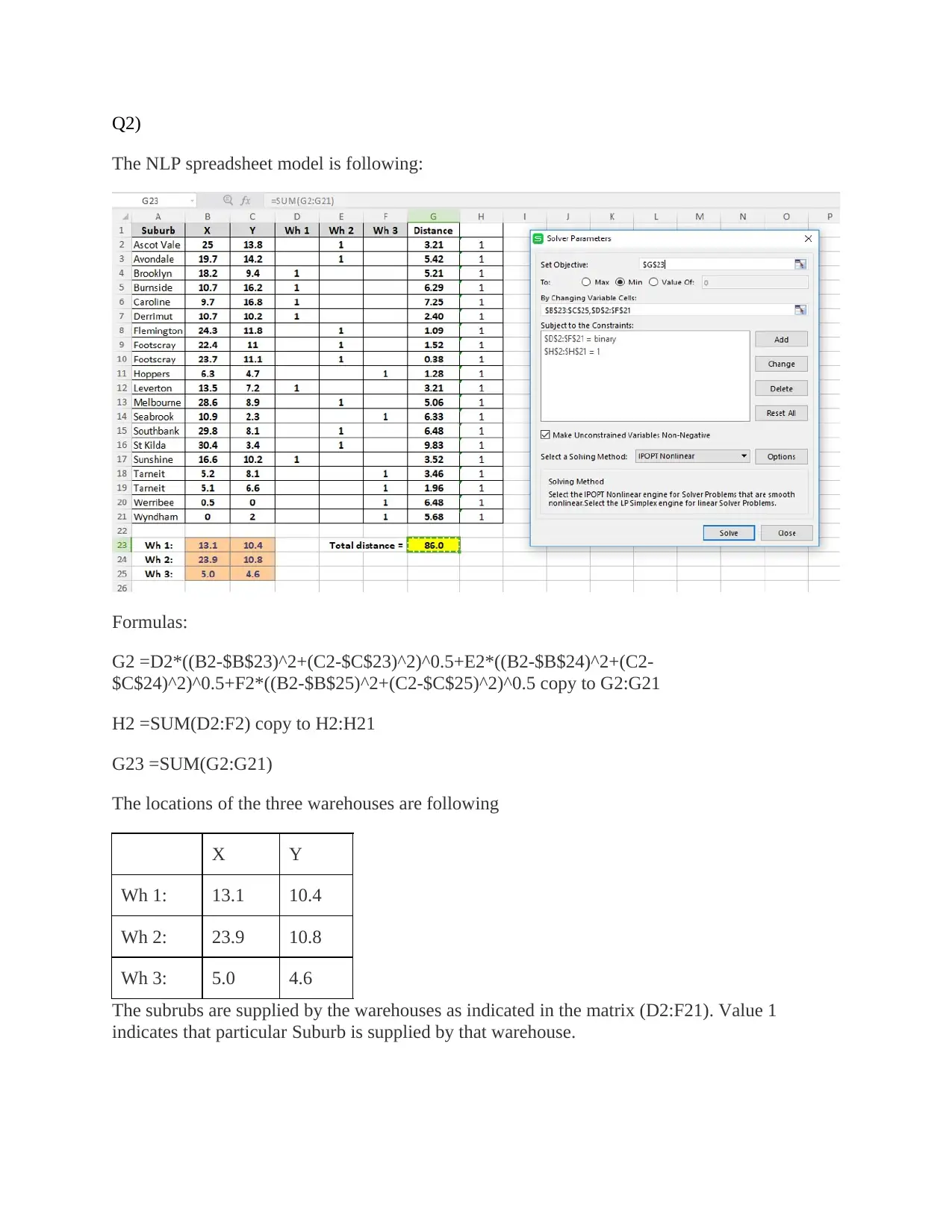
Q2)
The NLP spreadsheet model is following:
Formulas:
G2 =D2*((B2-$B$23)^2+(C2-$C$23)^2)^0.5+E2*((B2-$B$24)^2+(C2-
$C$24)^2)^0.5+F2*((B2-$B$25)^2+(C2-$C$25)^2)^0.5 copy to G2:G21
H2 =SUM(D2:F2) copy to H2:H21
G23 =SUM(G2:G21)
The locations of the three warehouses are following
X Y
Wh 1: 13.1 10.4
Wh 2: 23.9 10.8
Wh 3: 5.0 4.6
The subrubs are supplied by the warehouses as indicated in the matrix (D2:F21). Value 1
indicates that particular Suburb is supplied by that warehouse.
The NLP spreadsheet model is following:
Formulas:
G2 =D2*((B2-$B$23)^2+(C2-$C$23)^2)^0.5+E2*((B2-$B$24)^2+(C2-
$C$24)^2)^0.5+F2*((B2-$B$25)^2+(C2-$C$25)^2)^0.5 copy to G2:G21
H2 =SUM(D2:F2) copy to H2:H21
G23 =SUM(G2:G21)
The locations of the three warehouses are following
X Y
Wh 1: 13.1 10.4
Wh 2: 23.9 10.8
Wh 3: 5.0 4.6
The subrubs are supplied by the warehouses as indicated in the matrix (D2:F21). Value 1
indicates that particular Suburb is supplied by that warehouse.
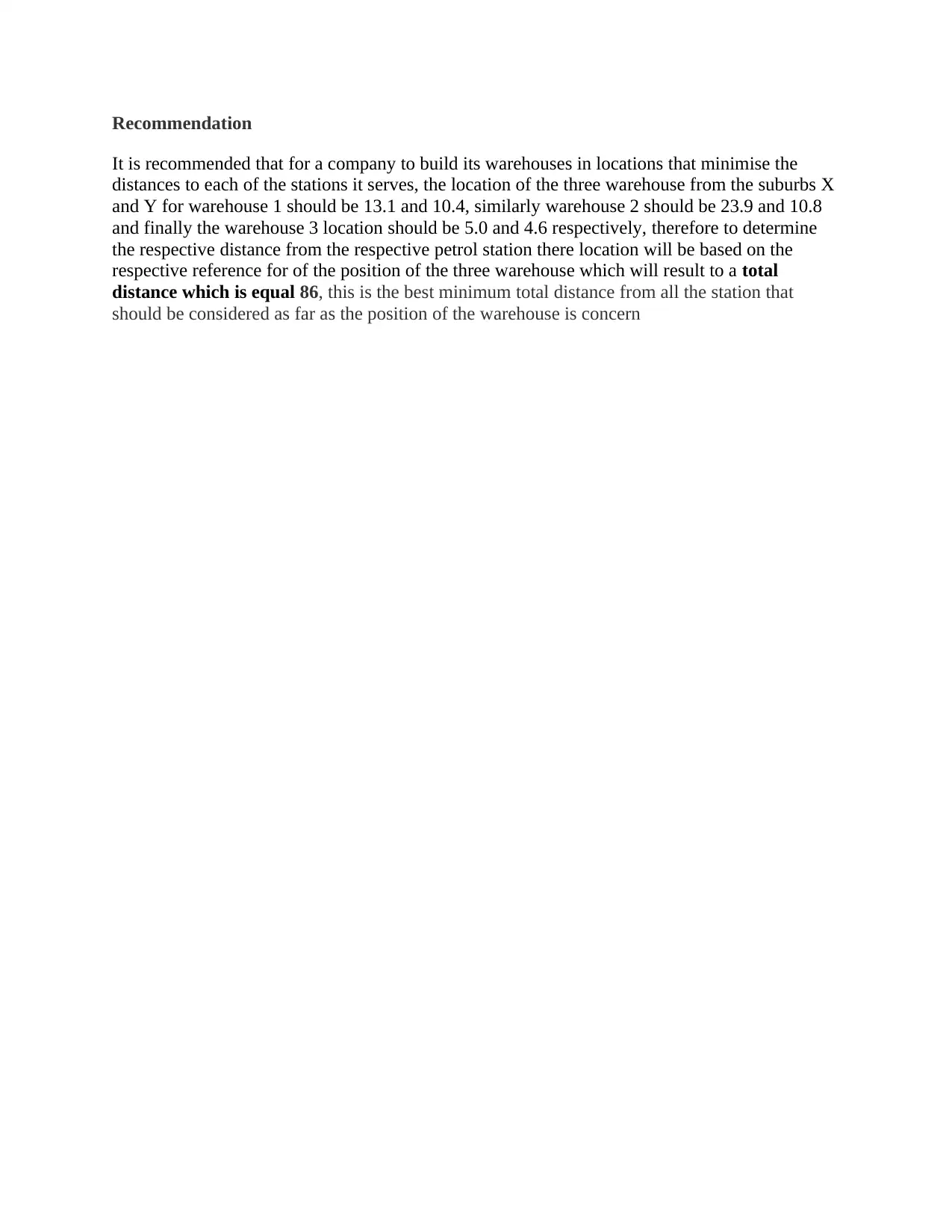
Recommendation
It is recommended that for a company to build its warehouses in locations that minimise the
distances to each of the stations it serves, the location of the three warehouse from the suburbs X
and Y for warehouse 1 should be 13.1 and 10.4, similarly warehouse 2 should be 23.9 and 10.8
and finally the warehouse 3 location should be 5.0 and 4.6 respectively, therefore to determine
the respective distance from the respective petrol station there location will be based on the
respective reference for of the position of the three warehouse which will result to a total
distance which is equal 86, this is the best minimum total distance from all the station that
should be considered as far as the position of the warehouse is concern
It is recommended that for a company to build its warehouses in locations that minimise the
distances to each of the stations it serves, the location of the three warehouse from the suburbs X
and Y for warehouse 1 should be 13.1 and 10.4, similarly warehouse 2 should be 23.9 and 10.8
and finally the warehouse 3 location should be 5.0 and 4.6 respectively, therefore to determine
the respective distance from the respective petrol station there location will be based on the
respective reference for of the position of the three warehouse which will result to a total
distance which is equal 86, this is the best minimum total distance from all the station that
should be considered as far as the position of the warehouse is concern
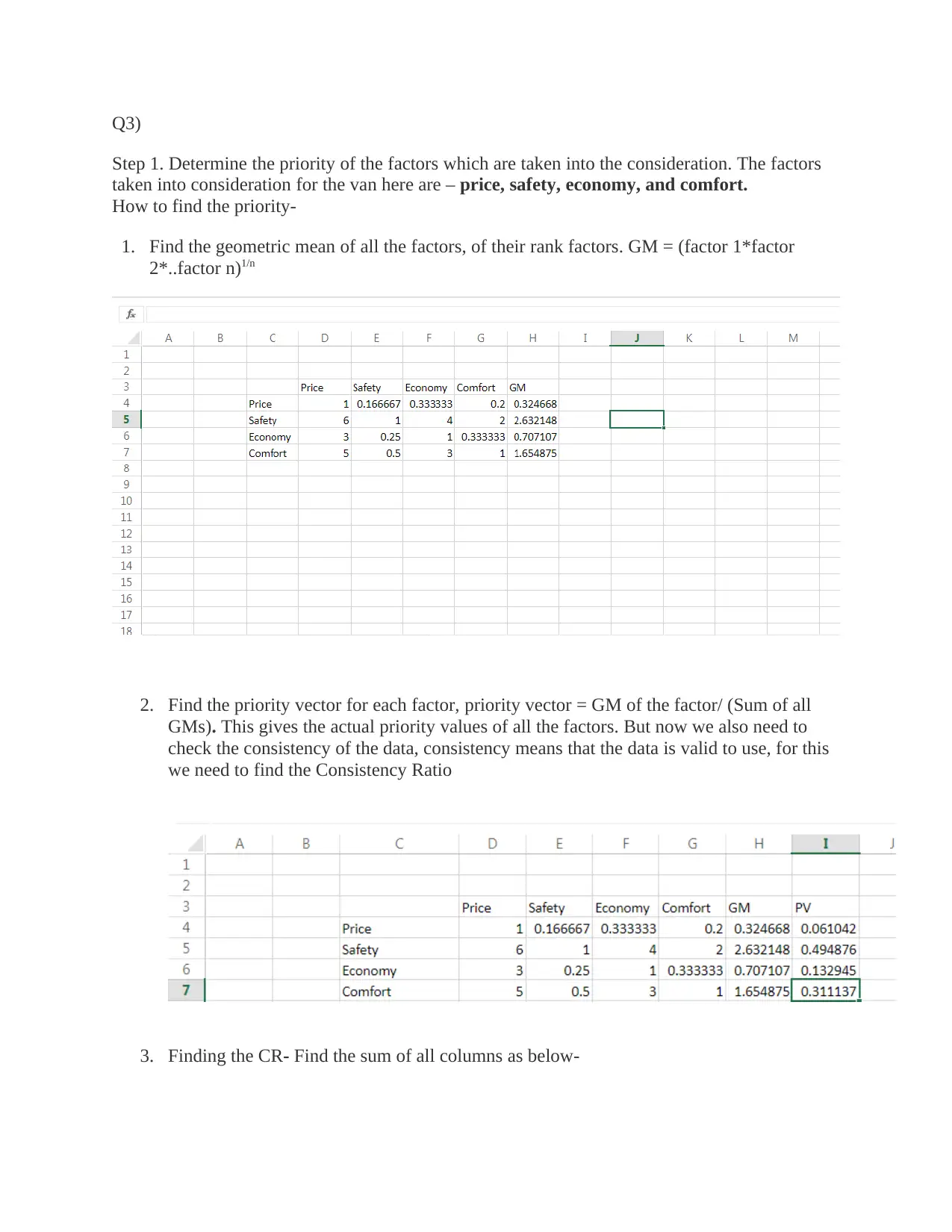
Q3)
Step 1. Determine the priority of the factors which are taken into the consideration. The factors
taken into consideration for the van here are – price, safety, economy, and comfort.
How to find the priority-
1. Find the geometric mean of all the factors, of their rank factors. GM = (factor 1*factor
2*..factor n)1/n
2. Find the priority vector for each factor, priority vector = GM of the factor/ (Sum of all
GMs). This gives the actual priority values of all the factors. But now we also need to
check the consistency of the data, consistency means that the data is valid to use, for this
we need to find the Consistency Ratio
3. Finding the CR- Find the sum of all columns as below-
Step 1. Determine the priority of the factors which are taken into the consideration. The factors
taken into consideration for the van here are – price, safety, economy, and comfort.
How to find the priority-
1. Find the geometric mean of all the factors, of their rank factors. GM = (factor 1*factor
2*..factor n)1/n
2. Find the priority vector for each factor, priority vector = GM of the factor/ (Sum of all
GMs). This gives the actual priority values of all the factors. But now we also need to
check the consistency of the data, consistency means that the data is valid to use, for this
we need to find the Consistency Ratio
3. Finding the CR- Find the sum of all columns as below-
Paraphrase This Document
Need a fresh take? Get an instant paraphrase of this document with our AI Paraphraser
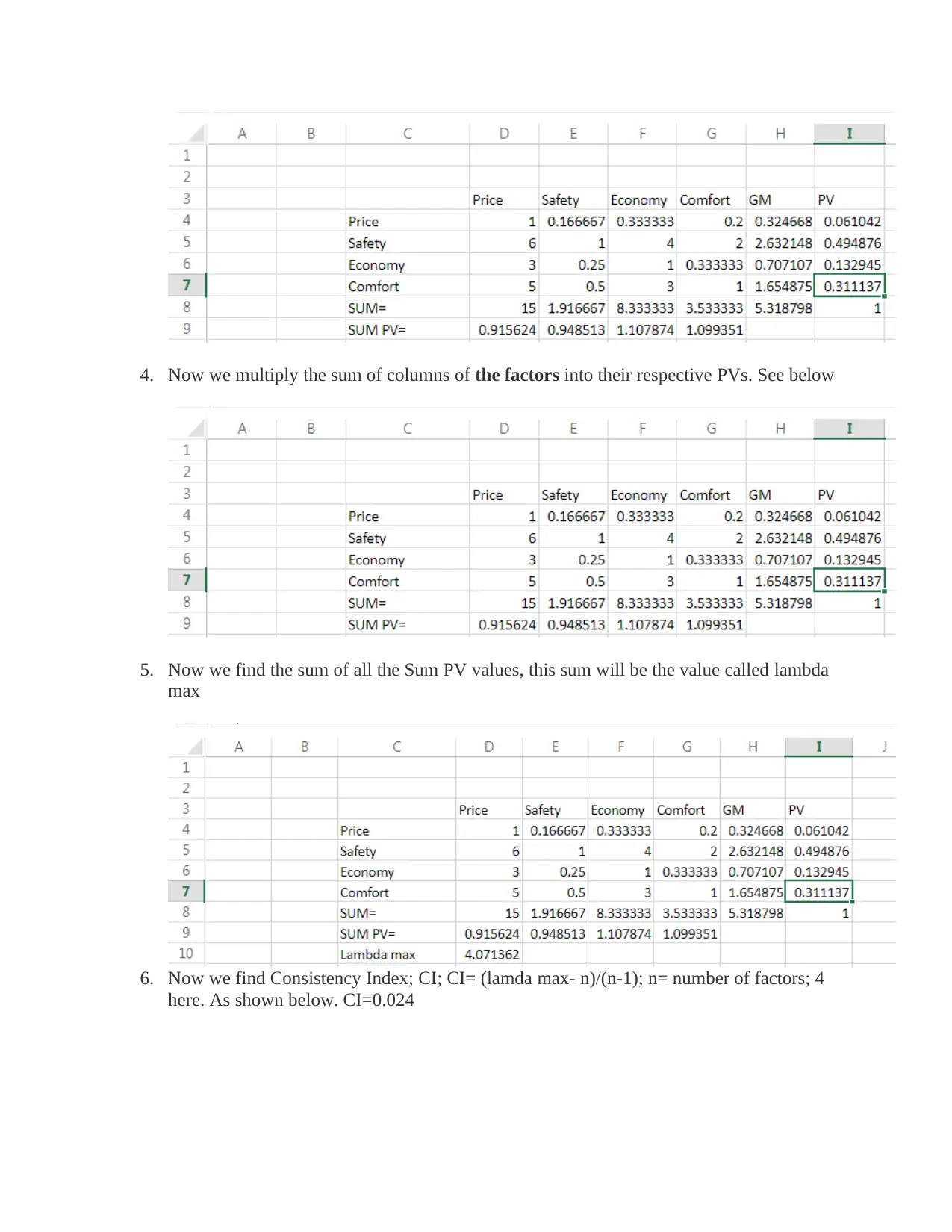
4. Now we multiply the sum of columns of the factors into their respective PVs. See below
5. Now we find the sum of all the Sum PV values, this sum will be the value called lambda
max
6. Now we find Consistency Index; CI; CI= (lamda max- n)/(n-1); n= number of factors; 4
here. As shown below. CI=0.024
5. Now we find the sum of all the Sum PV values, this sum will be the value called lambda
max
6. Now we find Consistency Index; CI; CI= (lamda max- n)/(n-1); n= number of factors; 4
here. As shown below. CI=0.024
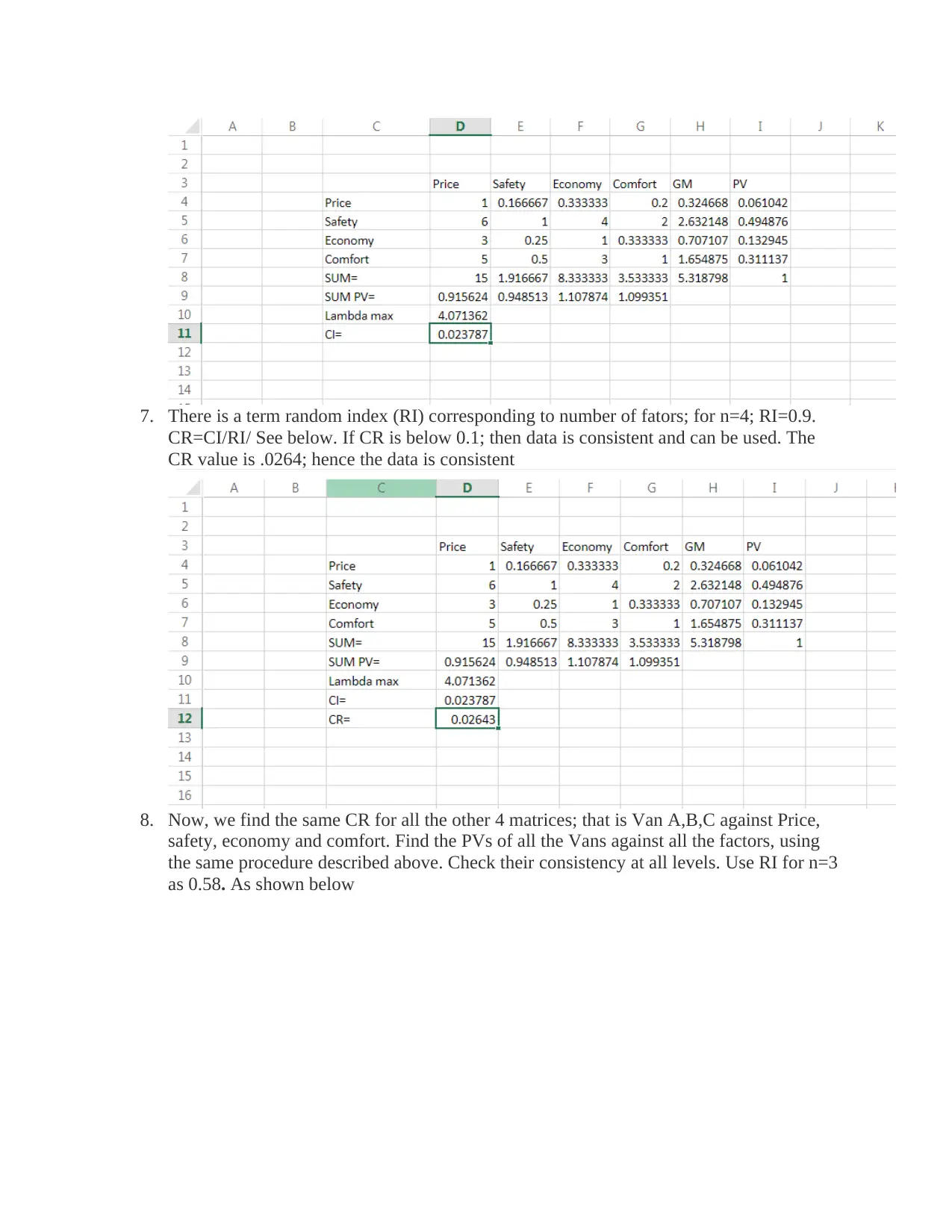
7. There is a term random index (RI) corresponding to number of fators; for n=4; RI=0.9.
CR=CI/RI/ See below. If CR is below 0.1; then data is consistent and can be used. The
CR value is .0264; hence the data is consistent
8. Now, we find the same CR for all the other 4 matrices; that is Van A,B,C against Price,
safety, economy and comfort. Find the PVs of all the Vans against all the factors, using
the same procedure described above. Check their consistency at all levels. Use RI for n=3
as 0.58. As shown below
CR=CI/RI/ See below. If CR is below 0.1; then data is consistent and can be used. The
CR value is .0264; hence the data is consistent
8. Now, we find the same CR for all the other 4 matrices; that is Van A,B,C against Price,
safety, economy and comfort. Find the PVs of all the Vans against all the factors, using
the same procedure described above. Check their consistency at all levels. Use RI for n=3
as 0.58. As shown below
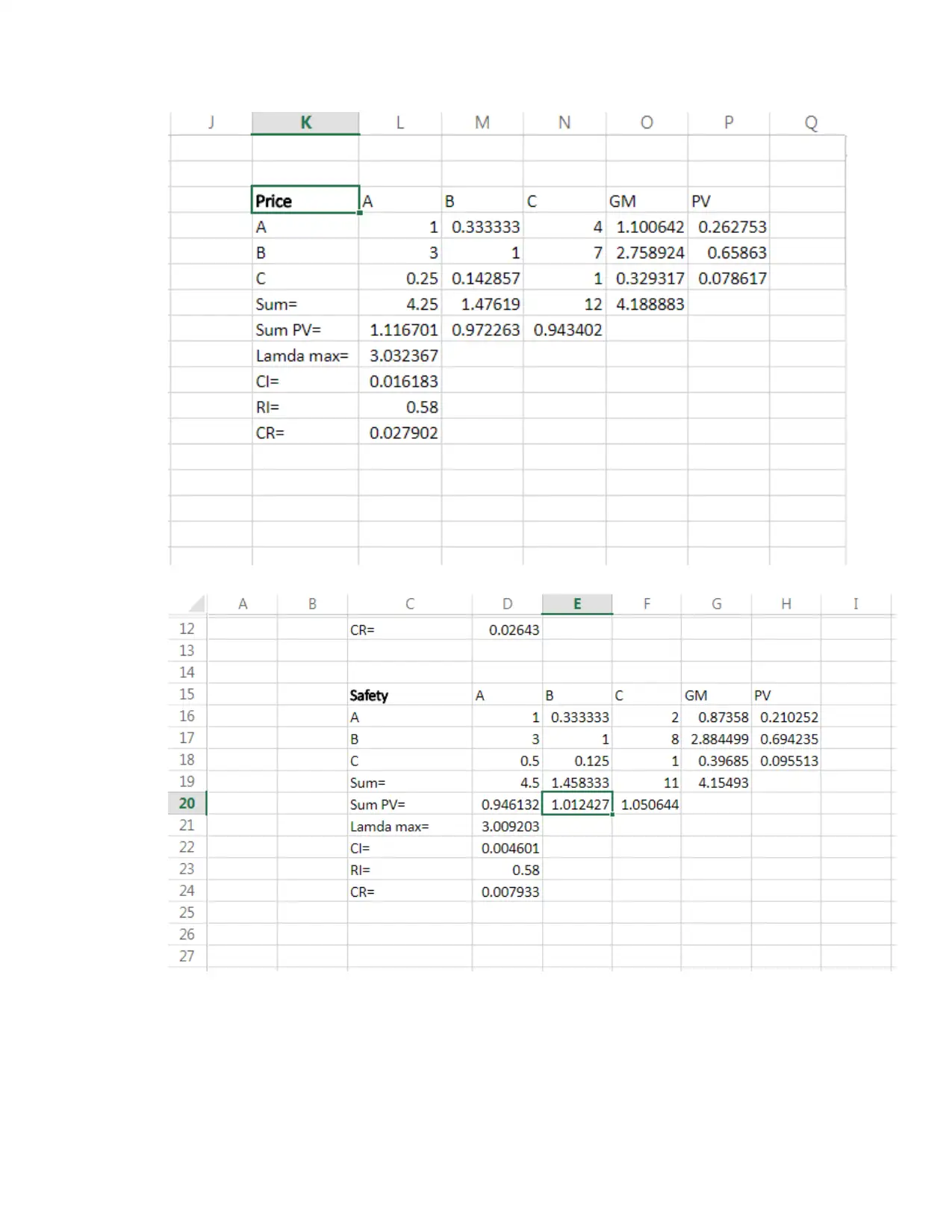
Secure Best Marks with AI Grader
Need help grading? Try our AI Grader for instant feedback on your assignments.
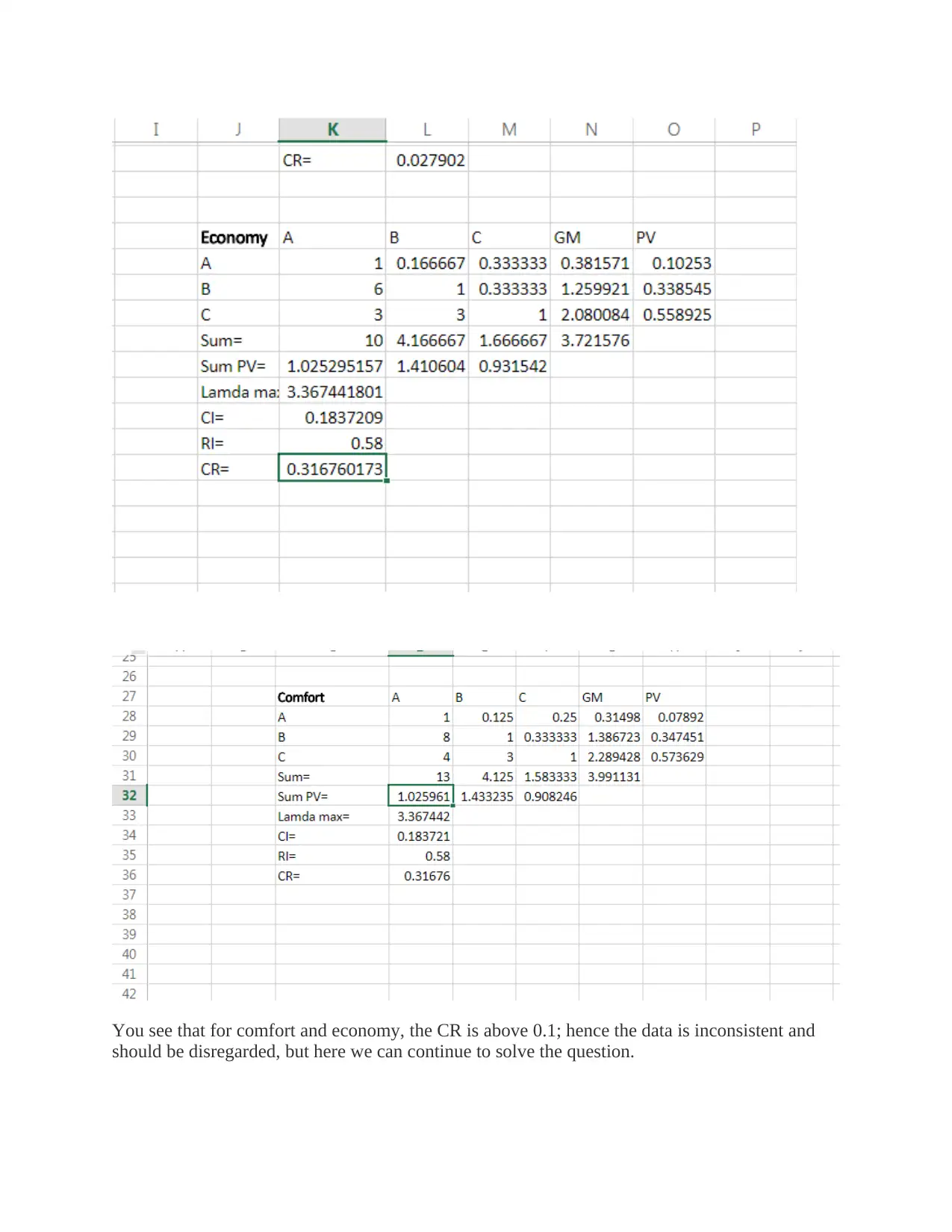
You see that for comfort and economy, the CR is above 0.1; hence the data is inconsistent and
should be disregarded, but here we can continue to solve the question.
should be disregarded, but here we can continue to solve the question.
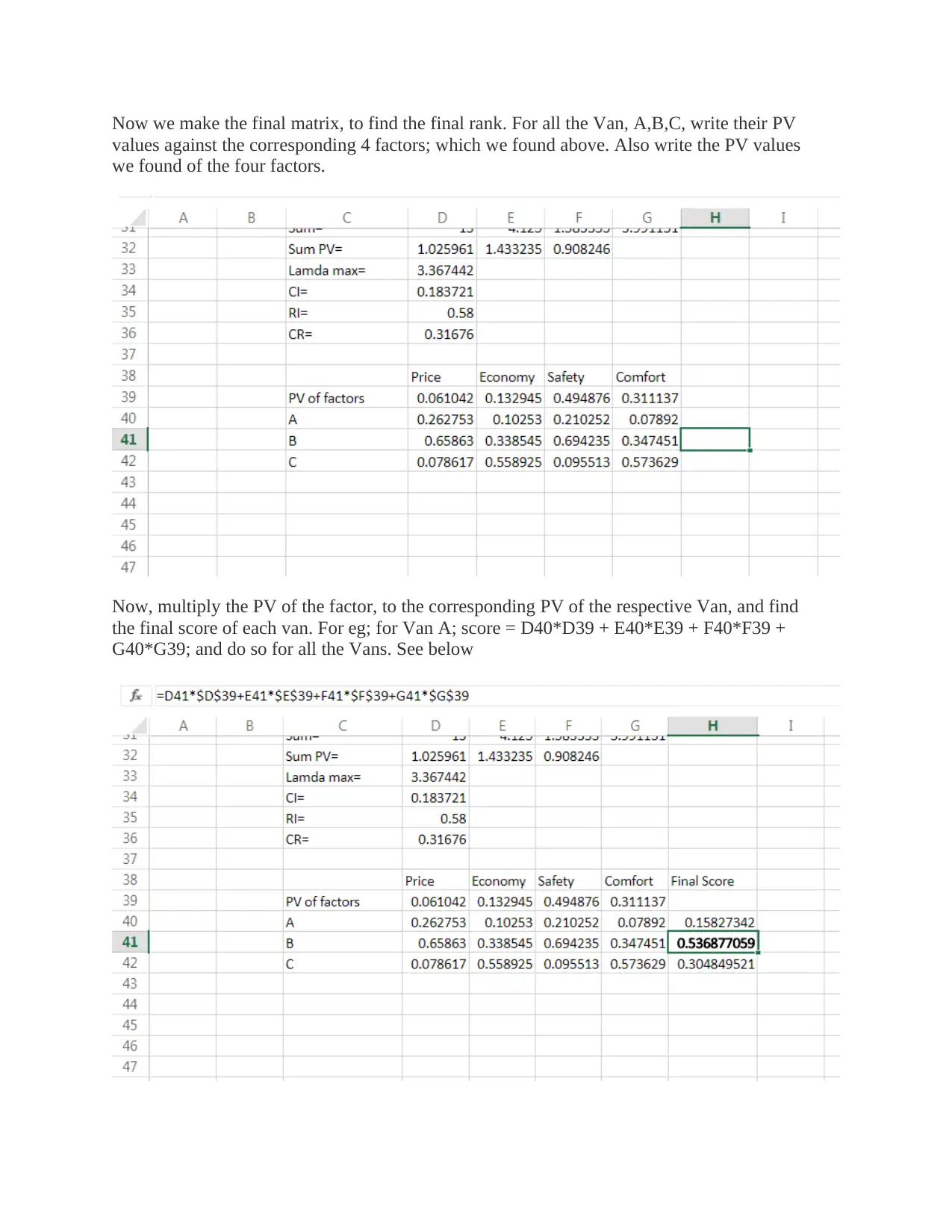
Now we make the final matrix, to find the final rank. For all the Van, A,B,C, write their PV
values against the corresponding 4 factors; which we found above. Also write the PV values
we found of the four factors.
Now, multiply the PV of the factor, to the corresponding PV of the respective Van, and find
the final score of each van. For eg; for Van A; score = D40*D39 + E40*E39 + F40*F39 +
G40*G39; and do so for all the Vans. See below
values against the corresponding 4 factors; which we found above. Also write the PV values
we found of the four factors.
Now, multiply the PV of the factor, to the corresponding PV of the respective Van, and find
the final score of each van. For eg; for Van A; score = D40*D39 + E40*E39 + F40*F39 +
G40*G39; and do so for all the Vans. See below
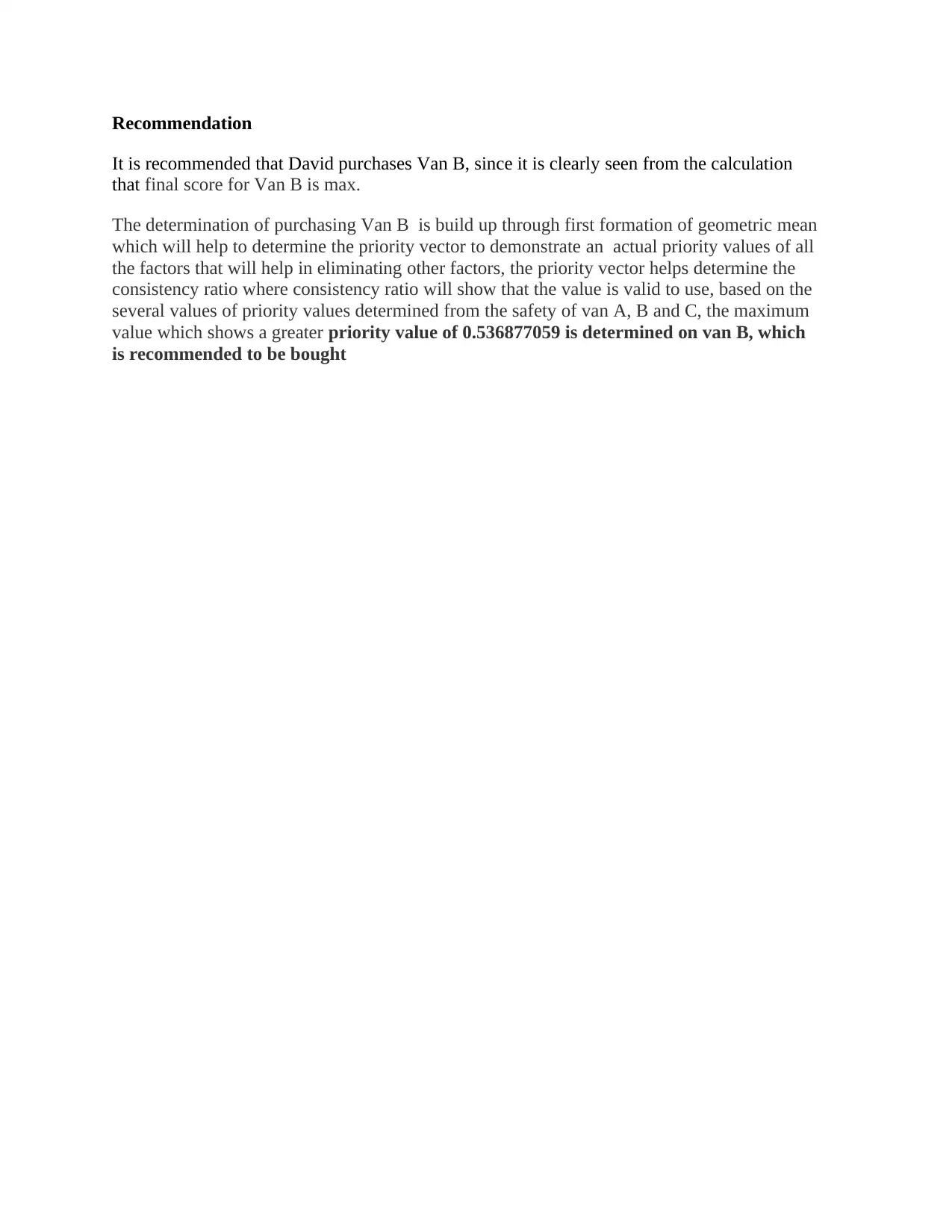
Recommendation
It is recommended that David purchases Van B, since it is clearly seen from the calculation
that final score for Van B is max.
The determination of purchasing Van B is build up through first formation of geometric mean
which will help to determine the priority vector to demonstrate an actual priority values of all
the factors that will help in eliminating other factors, the priority vector helps determine the
consistency ratio where consistency ratio will show that the value is valid to use, based on the
several values of priority values determined from the safety of van A, B and C, the maximum
value which shows a greater priority value of 0.536877059 is determined on van B, which
is recommended to be bought
It is recommended that David purchases Van B, since it is clearly seen from the calculation
that final score for Van B is max.
The determination of purchasing Van B is build up through first formation of geometric mean
which will help to determine the priority vector to demonstrate an actual priority values of all
the factors that will help in eliminating other factors, the priority vector helps determine the
consistency ratio where consistency ratio will show that the value is valid to use, based on the
several values of priority values determined from the safety of van A, B and C, the maximum
value which shows a greater priority value of 0.536877059 is determined on van B, which
is recommended to be bought
Paraphrase This Document
Need a fresh take? Get an instant paraphrase of this document with our AI Paraphraser
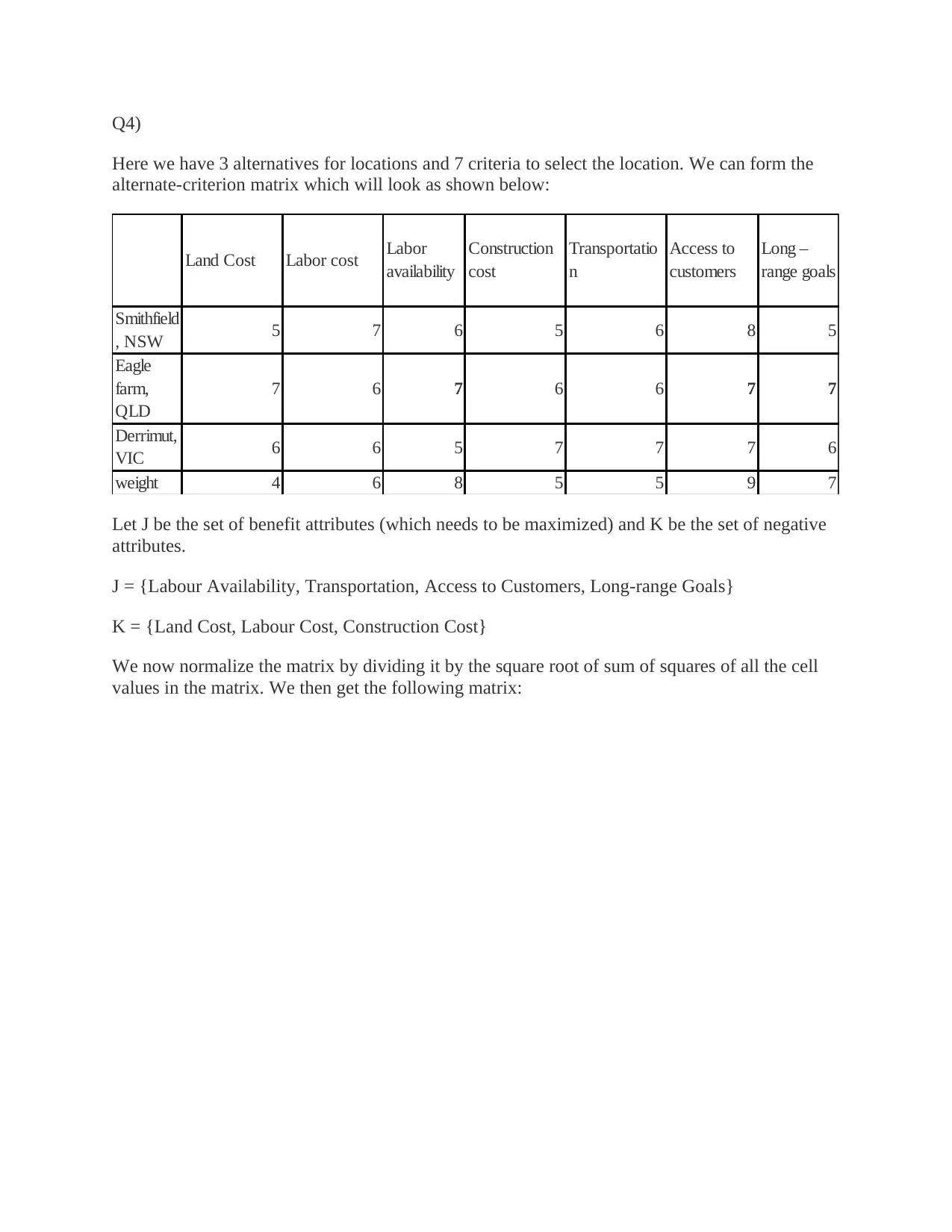
Q4)
Here we have 3 alternatives for locations and 7 criteria to select the location. We can form the
alternate-criterion matrix which will look as shown below:
Land Cost Labor cost Labor
availability
Construction
cost
Transportatio
n
Access to
customers
Long –
range goals
Smithfield
, NSW 5 7 6 5 6 8 5
Eagle
farm,
QLD
7 6 7 6 6 7 7
Derrimut,
VIC 6 6 5 7 7 7 6
weight 4 6 8 5 5 9 7
Let J be the set of benefit attributes (which needs to be maximized) and K be the set of negative
attributes.
J = {Labour Availability, Transportation, Access to Customers, Long-range Goals}
K = {Land Cost, Labour Cost, Construction Cost}
We now normalize the matrix by dividing it by the square root of sum of squares of all the cell
values in the matrix. We then get the following matrix:
Here we have 3 alternatives for locations and 7 criteria to select the location. We can form the
alternate-criterion matrix which will look as shown below:
Land Cost Labor cost Labor
availability
Construction
cost
Transportatio
n
Access to
customers
Long –
range goals
Smithfield
, NSW 5 7 6 5 6 8 5
Eagle
farm,
QLD
7 6 7 6 6 7 7
Derrimut,
VIC 6 6 5 7 7 7 6
weight 4 6 8 5 5 9 7
Let J be the set of benefit attributes (which needs to be maximized) and K be the set of negative
attributes.
J = {Labour Availability, Transportation, Access to Customers, Long-range Goals}
K = {Land Cost, Labour Cost, Construction Cost}
We now normalize the matrix by dividing it by the square root of sum of squares of all the cell
values in the matrix. We then get the following matrix:
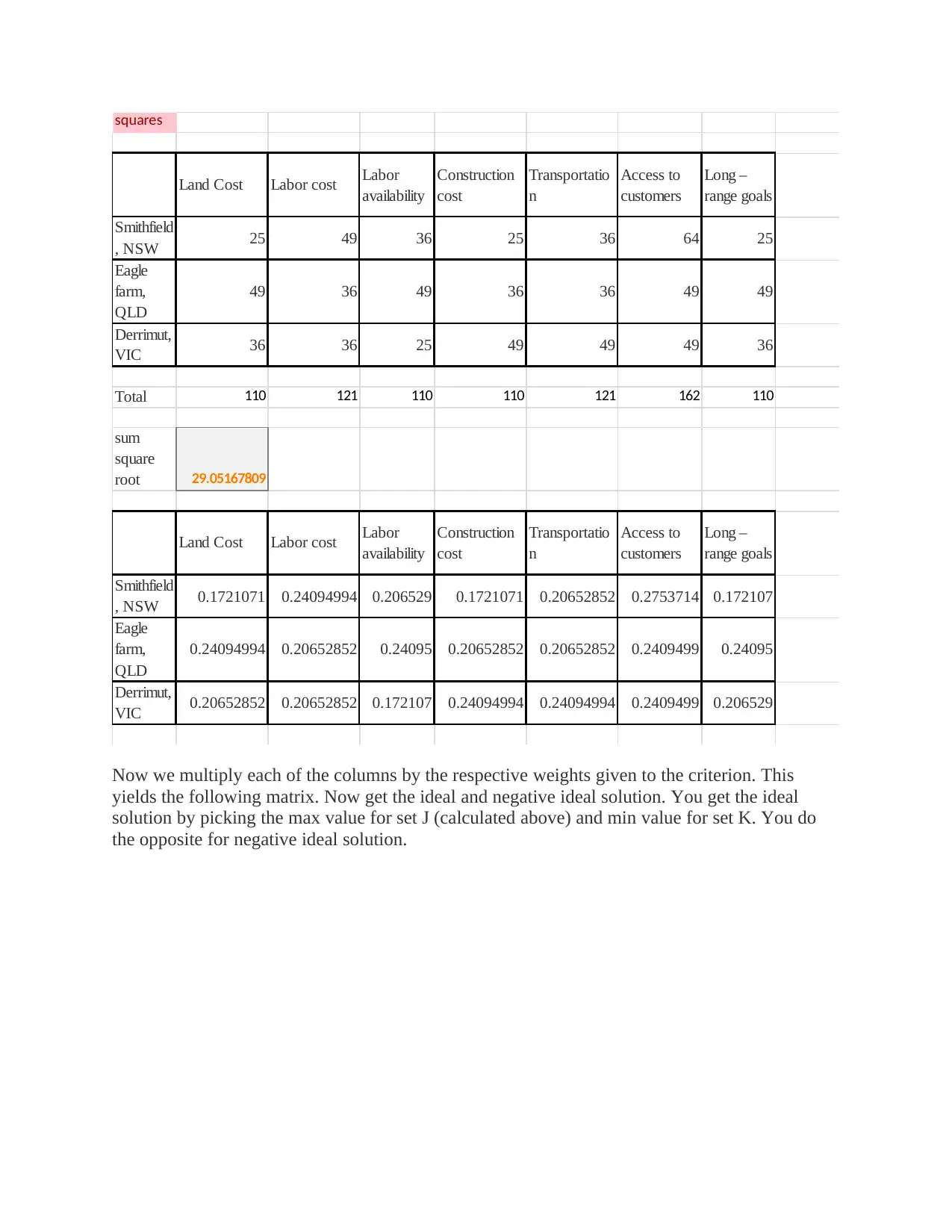
squares
Land Cost Labor cost Labor
availability
Construction
cost
Transportatio
n
Access to
customers
Long –
range goals
Smithfield
, NSW 25 49 36 25 36 64 25
Eagle
farm,
QLD
49 36 49 36 36 49 49
Derrimut,
VIC 36 36 25 49 49 49 36
Total 110 121 110 110 121 162 110
sum
square
root 29.05167809
Land Cost Labor cost Labor
availability
Construction
cost
Transportatio
n
Access to
customers
Long –
range goals
Smithfield
, NSW 0.1721071 0.24094994 0.206529 0.1721071 0.20652852 0.2753714 0.172107
Eagle
farm,
QLD
0.24094994 0.20652852 0.24095 0.20652852 0.20652852 0.2409499 0.24095
Derrimut,
VIC 0.20652852 0.20652852 0.172107 0.24094994 0.24094994 0.2409499 0.206529
Now we multiply each of the columns by the respective weights given to the criterion. This
yields the following matrix. Now get the ideal and negative ideal solution. You get the ideal
solution by picking the max value for set J (calculated above) and min value for set K. You do
the opposite for negative ideal solution.
Land Cost Labor cost Labor
availability
Construction
cost
Transportatio
n
Access to
customers
Long –
range goals
Smithfield
, NSW 25 49 36 25 36 64 25
Eagle
farm,
QLD
49 36 49 36 36 49 49
Derrimut,
VIC 36 36 25 49 49 49 36
Total 110 121 110 110 121 162 110
sum
square
root 29.05167809
Land Cost Labor cost Labor
availability
Construction
cost
Transportatio
n
Access to
customers
Long –
range goals
Smithfield
, NSW 0.1721071 0.24094994 0.206529 0.1721071 0.20652852 0.2753714 0.172107
Eagle
farm,
QLD
0.24094994 0.20652852 0.24095 0.20652852 0.20652852 0.2409499 0.24095
Derrimut,
VIC 0.20652852 0.20652852 0.172107 0.24094994 0.24094994 0.2409499 0.206529
Now we multiply each of the columns by the respective weights given to the criterion. This
yields the following matrix. Now get the ideal and negative ideal solution. You get the ideal
solution by picking the max value for set J (calculated above) and min value for set K. You do
the opposite for negative ideal solution.
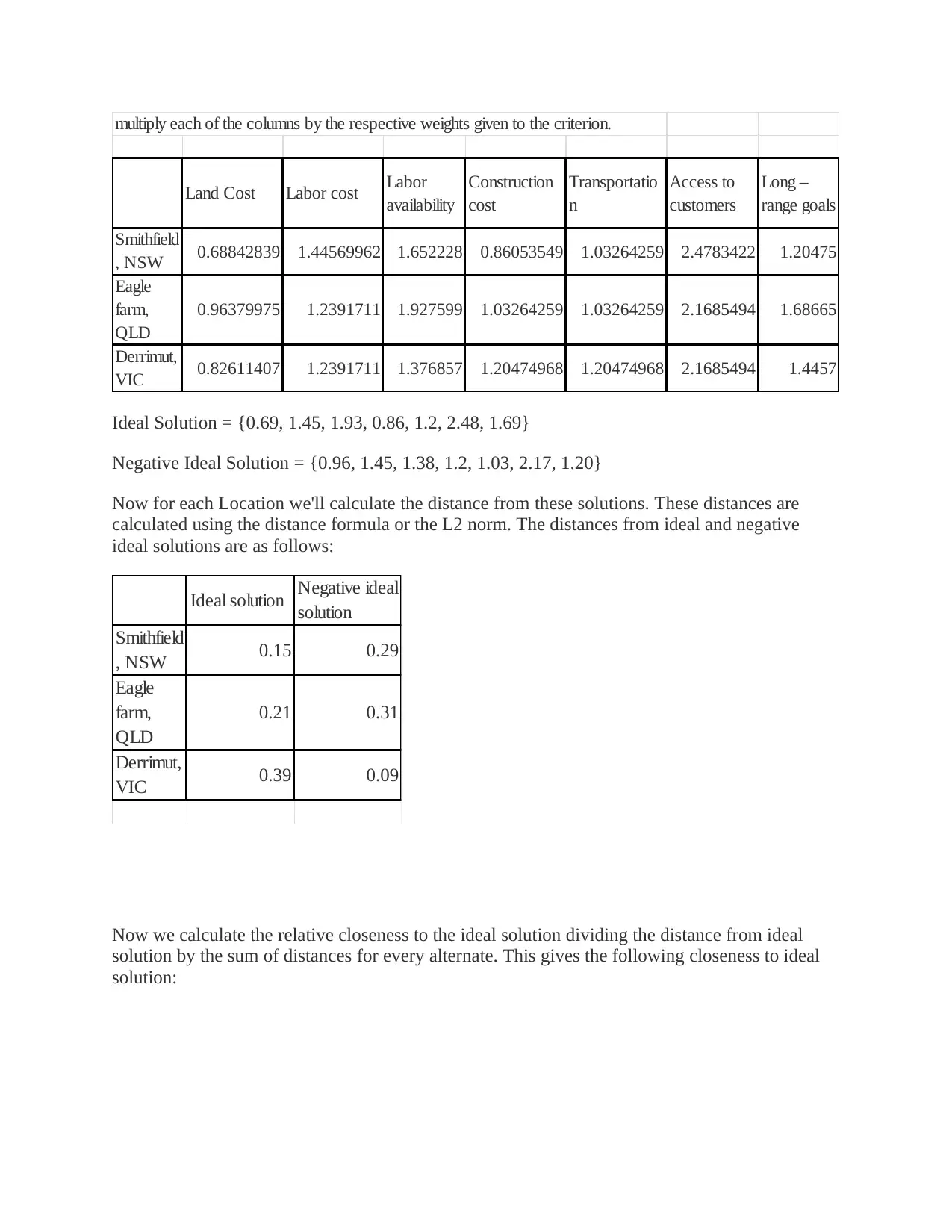
multiply each of the columns by the respective weights given to the criterion.
Land Cost Labor cost Labor
availability
Construction
cost
Transportatio
n
Access to
customers
Long –
range goals
Smithfield
, NSW 0.68842839 1.44569962 1.652228 0.86053549 1.03264259 2.4783422 1.20475
Eagle
farm,
QLD
0.96379975 1.2391711 1.927599 1.03264259 1.03264259 2.1685494 1.68665
Derrimut,
VIC 0.82611407 1.2391711 1.376857 1.20474968 1.20474968 2.1685494 1.4457
Ideal Solution = {0.69, 1.45, 1.93, 0.86, 1.2, 2.48, 1.69}
Negative Ideal Solution = {0.96, 1.45, 1.38, 1.2, 1.03, 2.17, 1.20}
Now for each Location we'll calculate the distance from these solutions. These distances are
calculated using the distance formula or the L2 norm. The distances from ideal and negative
ideal solutions are as follows:
Ideal solution Negative ideal
solution
Smithfield
, NSW 0.15 0.29
Eagle
farm,
QLD
0.21 0.31
Derrimut,
VIC 0.39 0.09
Now we calculate the relative closeness to the ideal solution dividing the distance from ideal
solution by the sum of distances for every alternate. This gives the following closeness to ideal
solution:
Land Cost Labor cost Labor
availability
Construction
cost
Transportatio
n
Access to
customers
Long –
range goals
Smithfield
, NSW 0.68842839 1.44569962 1.652228 0.86053549 1.03264259 2.4783422 1.20475
Eagle
farm,
QLD
0.96379975 1.2391711 1.927599 1.03264259 1.03264259 2.1685494 1.68665
Derrimut,
VIC 0.82611407 1.2391711 1.376857 1.20474968 1.20474968 2.1685494 1.4457
Ideal Solution = {0.69, 1.45, 1.93, 0.86, 1.2, 2.48, 1.69}
Negative Ideal Solution = {0.96, 1.45, 1.38, 1.2, 1.03, 2.17, 1.20}
Now for each Location we'll calculate the distance from these solutions. These distances are
calculated using the distance formula or the L2 norm. The distances from ideal and negative
ideal solutions are as follows:
Ideal solution Negative ideal
solution
Smithfield
, NSW 0.15 0.29
Eagle
farm,
QLD
0.21 0.31
Derrimut,
VIC 0.39 0.09
Now we calculate the relative closeness to the ideal solution dividing the distance from ideal
solution by the sum of distances for every alternate. This gives the following closeness to ideal
solution:
Secure Best Marks with AI Grader
Need help grading? Try our AI Grader for instant feedback on your assignments.
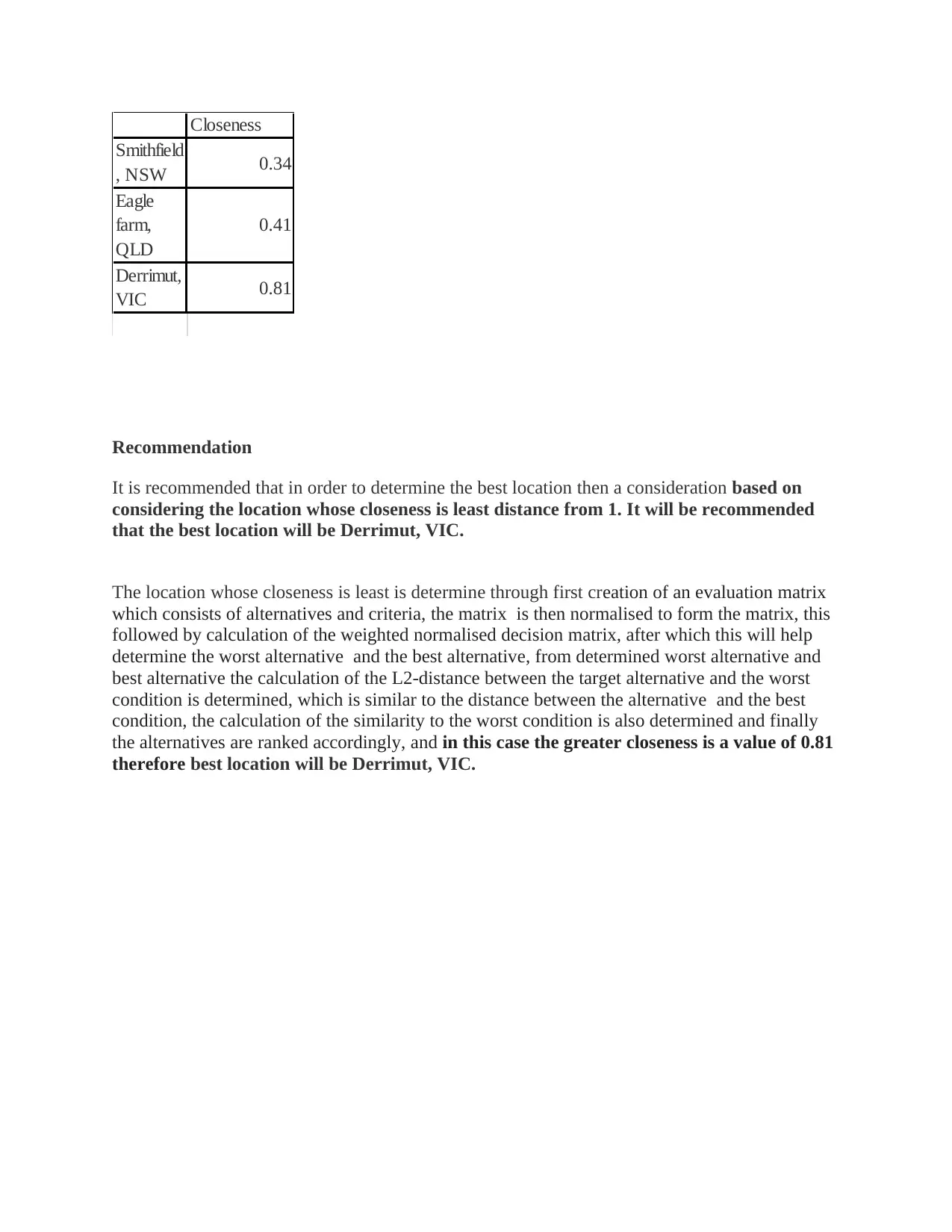
Closeness
Smithfield
, NSW 0.34
Eagle
farm,
QLD
0.41
Derrimut,
VIC 0.81
Recommendation
It is recommended that in order to determine the best location then a consideration based on
considering the location whose closeness is least distance from 1. It will be recommended
that the best location will be Derrimut, VIC.
The location whose closeness is least is determine through first creation of an evaluation matrix
which consists of alternatives and criteria, the matrix is then normalised to form the matrix, this
followed by calculation of the weighted normalised decision matrix, after which this will help
determine the worst alternative and the best alternative, from determined worst alternative and
best alternative the calculation of the L2-distance between the target alternative and the worst
condition is determined, which is similar to the distance between the alternative and the best
condition, the calculation of the similarity to the worst condition is also determined and finally
the alternatives are ranked accordingly, and in this case the greater closeness is a value of 0.81
therefore best location will be Derrimut, VIC.
Smithfield
, NSW 0.34
Eagle
farm,
QLD
0.41
Derrimut,
VIC 0.81
Recommendation
It is recommended that in order to determine the best location then a consideration based on
considering the location whose closeness is least distance from 1. It will be recommended
that the best location will be Derrimut, VIC.
The location whose closeness is least is determine through first creation of an evaluation matrix
which consists of alternatives and criteria, the matrix is then normalised to form the matrix, this
followed by calculation of the weighted normalised decision matrix, after which this will help
determine the worst alternative and the best alternative, from determined worst alternative and
best alternative the calculation of the L2-distance between the target alternative and the worst
condition is determined, which is similar to the distance between the alternative and the best
condition, the calculation of the similarity to the worst condition is also determined and finally
the alternatives are ranked accordingly, and in this case the greater closeness is a value of 0.81
therefore best location will be Derrimut, VIC.
1 out of 17
Related Documents
Your All-in-One AI-Powered Toolkit for Academic Success.
+13062052269
info@desklib.com
Available 24*7 on WhatsApp / Email
![[object Object]](/_next/static/media/star-bottom.7253800d.svg)
Unlock your academic potential
© 2024 | Zucol Services PVT LTD | All rights reserved.




